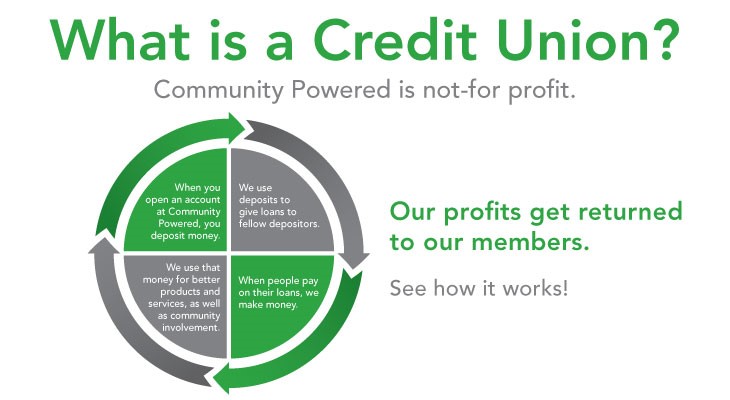Hybrid Line of Credit: Flexible Financing Options from Your Wyoming Credit Union
Hybrid Line of Credit: Flexible Financing Options from Your Wyoming Credit Union
Blog Article
The Ultimate Guide to Recognizing Cooperative Credit Union

Cooperative credit union stand as distinct economic entities, rooted in principles of mutual assistance and member-driven operations. Nonetheless, beyond their foundational values, comprehending the intricate operations of cooperative credit union includes a much deeper exploration. Unwinding the intricacies of membership qualification, the development of solutions provided, and the distinctive advantages they bring requires a detailed evaluation. As we browse via the details of lending institution, an informative trip waits for to drop light on these member-focused institutions and just how they differ from standard banks.
What Are Lending Institution?
Cooperative credit union are member-owned banks that supply a series of financial services to their participants. Unlike typical banks, credit score unions run as not-for-profit companies, meaning their primary focus is on serving their members instead of making best use of profits. Members of a cooperative credit union typically share a common bond, such as working for the same employer, belonging to the exact same area, or becoming part of the same company.
Among the key benefits of lending institution is that they often provide higher rate of interest on savings accounts and lower rate of interest prices on finances contrasted to banks. Federal Credit Union. This is due to the fact that cooperative credit union are structured to benefit their members straight, allowing them to pass on their revenues in the type of far better rates and fewer fees. Furthermore, lending institution are recognized for their customized client service, as they focus on building relationships with their members to understand their distinct monetary demands and goals
History and Evolution of Cooperative Credit Union
The roots of member-owned monetary cooperatives, recognized today as credit history unions, trace back to a time when areas looked for options to typical banking establishments. The principle of lending institution come from the 19th century in Europe, with Friedrich Wilhelm Raiffeisen typically credited as the leader of the participating financial movement. Raiffeisen founded the initial identified lending institution in Germany in the mid-1800s, highlighting neighborhood support and self-help principles.
The advancement of lending institution continued in The United States and copyright, where Alphonse Desjardins developed the initial cooperative credit union in copyright in 1900. Soon after, in 1909, the very first united state cooperative credit union was created in New Hampshire by a group of Franco-American immigrants. These very early lending institution operated the fundamental concepts of mutual aid, autonomous control, and member possession.
Gradually, cooperative credit union have expanded in popularity worldwide as a result of their not-for-profit structure, concentrate on offering members, and using competitive financial items and solutions. Today, cooperative credit union play a vital role in the economic market, supplying community-oriented and accessible financial alternatives for businesses and individuals alike.

Membership and Eligibility Requirements
Subscription at a credit union is usually limited to people fulfilling details eligibility requirements based upon the institution's founding principles and regulative needs. These standards typically consist of factors such as geographical area, employment condition, membership in certain organizations, or affiliation with particular groups. Lending institution are understood for their community-oriented technique, which is mirrored in their subscription requirements. Credit Unions in Wyoming. For instance, some go to the website cooperative credit union might just offer individuals who work or live in a specific location, while others may be tailored to employees of a particular firm or participants of a certain association.
In addition, credit history unions are structured as not-for-profit companies, meaning that their main goal is to offer their participants rather than generate profits for investors. This concentrate on member service often equates right into even more individualized attention, lower charges, and competitive rates of interest on finances and financial savings accounts. By satisfying the eligibility standards and becoming a participant of a cooperative credit union, individuals can access an array of financial products and solutions tailored to their details needs.
Services and Products Supplied
One of the essential aspects that sets credit history unions apart is the diverse range of monetary services and items they supply to their members. Credit history unions commonly give typical financial solutions such as financial savings and examining accounts, finances, and debt cards.
Furthermore, lending institution typically provide hassle-free online and mobile banking alternatives for members to easily handle their finances. They may offer perks such as common branching, enabling members to access their accounts at other credit score unions throughout the nation. Some credit unions likewise provide check insurance policy products like life, home, and automobile insurance policy to help participants protect their possessions and loved ones.

Benefits of Banking With Cooperative Credit Union
When considering financial organizations, exploring the advantages of banking with credit scores unions reveals special advantages for participants seeking personalized solution and competitive rates. Unlike huge financial institutions, debt unions are member-owned and focus on structure strong relationships with their participants. In general, financial with a credit scores union can provide an extra tailored, affordable, and member-centric monetary experience.
Conclusion
In conclusion, credit report unions stand out as member-owned economic institutions that prioritize offering their members over optimizing revenues. With origins dating back to 19th century Europe, credit unions adhere to concepts of shared support and member possession.
Debt unions are member-owned monetary organizations that use a variety of banking services to their participants. Website The concept of credit score unions come from in the 19th century in Europe, with Friedrich Wilhelm Raiffeisen frequently credited as the leader of the participating financial motion.The development of credit unions continued in North America, where Alphonse Desjardins developed the first credit union in copyright in 1900. Credit scores unions usually offer traditional financial services such as savings and inspecting accounts, financings, and debt cards.When thinking about financial establishments, checking out the advantages of financial with credit history unions reveals one-of-a-kind benefits for participants seeking personalized solution and competitive prices.
Report this page